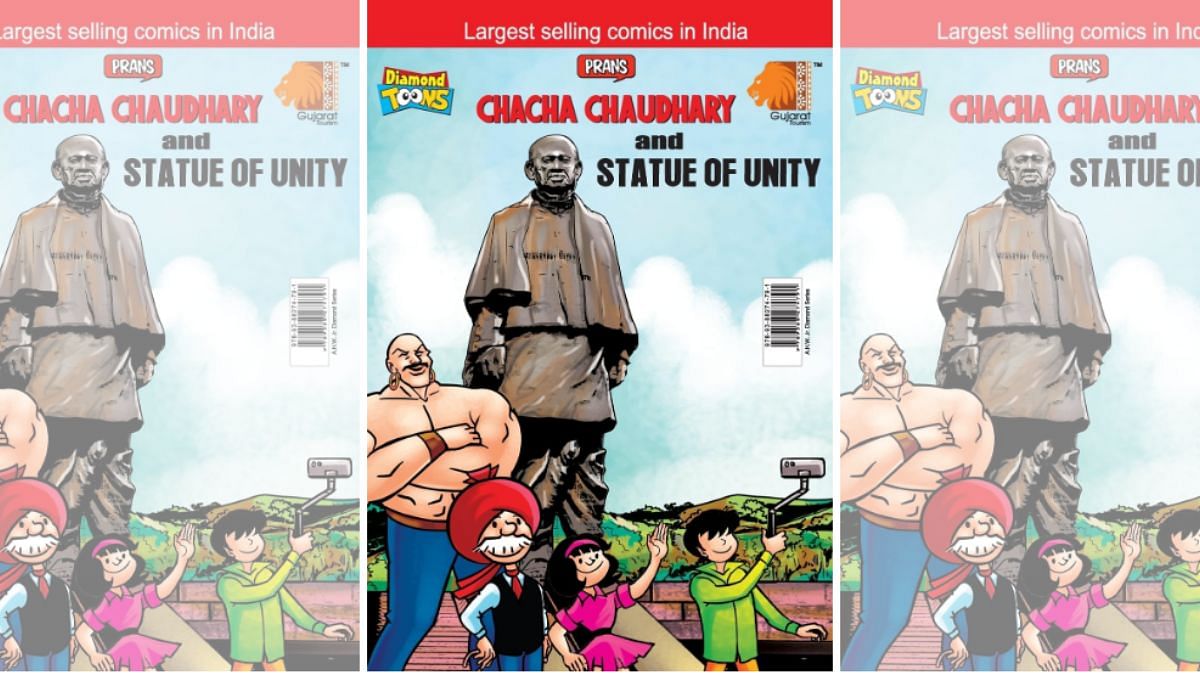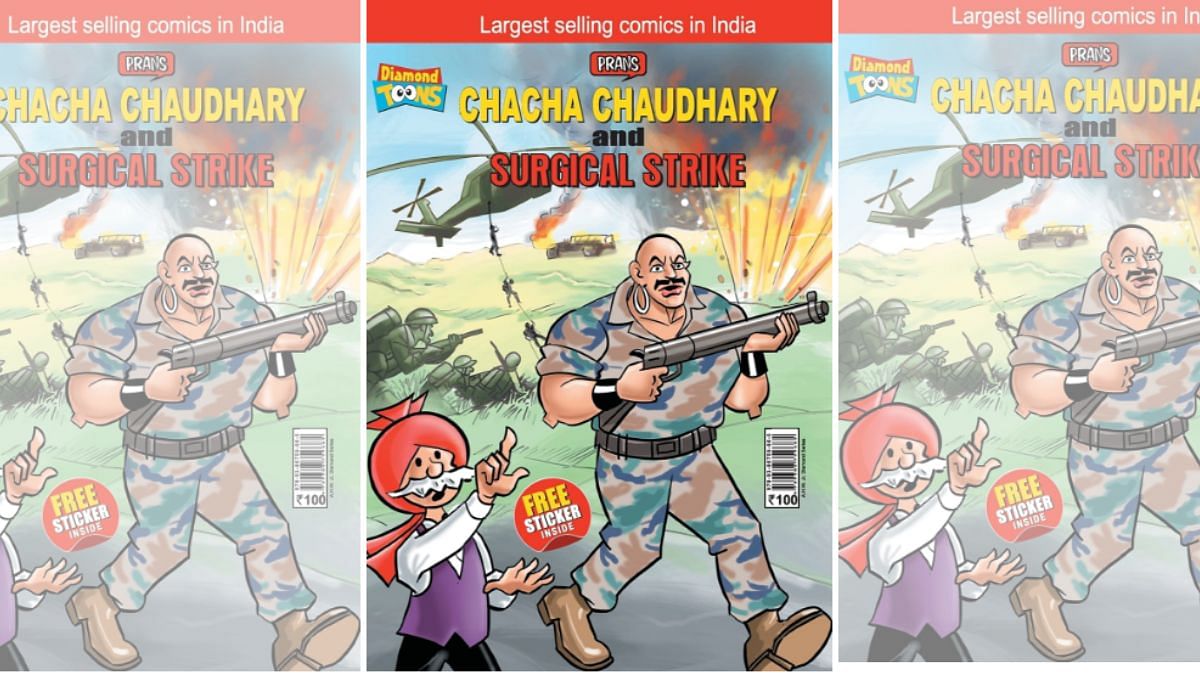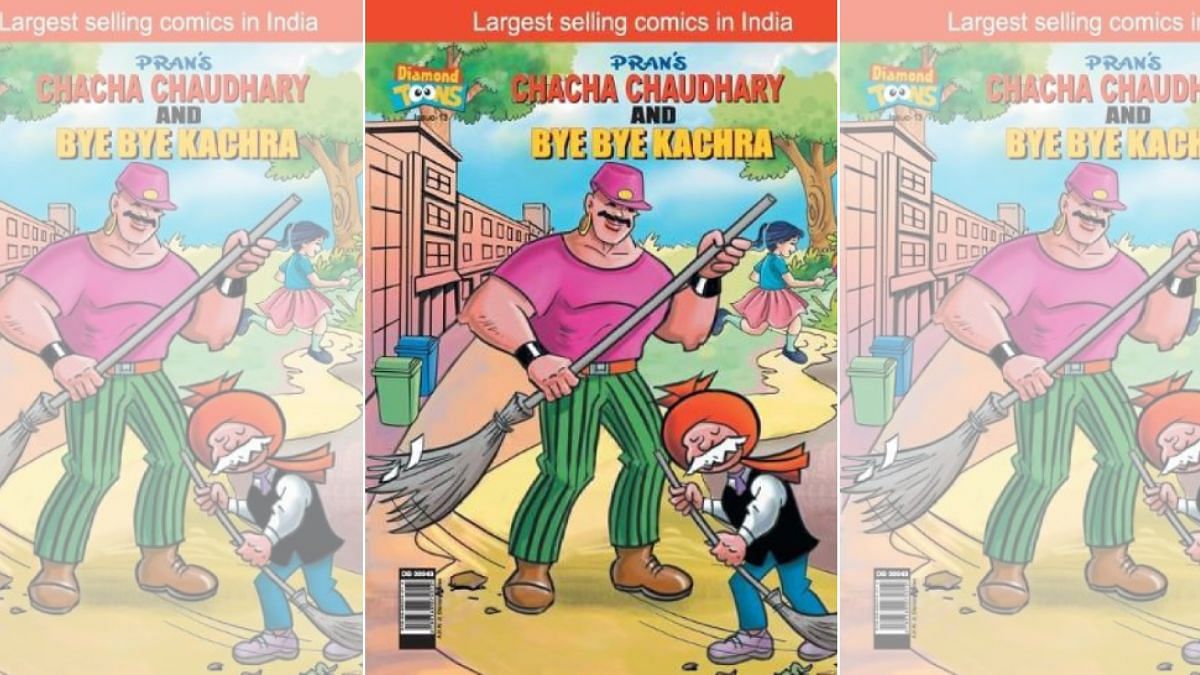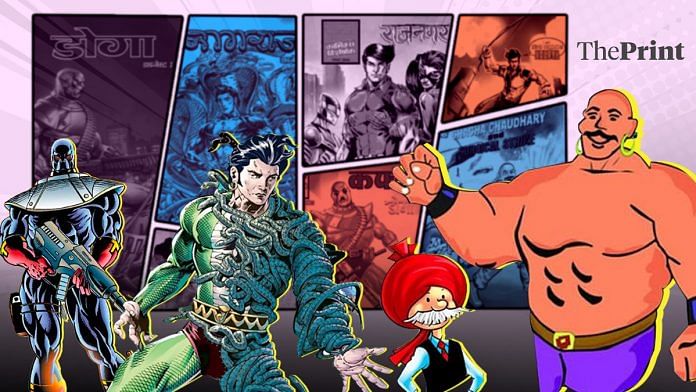Tick, tick, tick, tringgggggggg…an alarm clock that wakes Billoo up. It’s his 18th birthday. He gets ready even as thought bubbles surround him, filled with ideas of the newfound freedom. Now he can ride a bike, enter college, buy a smart phone and have a lot of fun. As he heads out, a voice stops him in the middle of the road, shouting: “The first duty of a youth is to become a voter.”
“Wait, who’s that …ohhh that’s Chacha Chaudhry,” says Billoo in Chacha Chaudhary aur Chunavi Dangal by Pran’s Features.
The comic book, which covers six themes on voter awareness, is one of the many contemporary iterations Indian comic publications are trying their hand at. And the big idea behind it is to stay relevant in the backdrop of manga and anime onslaught. In Chunavi Dangal, Chacha Chaudhry is not alone. Sabu, Raaka, Dhamaka Singh all come together to raise awareness on voter education, asking people to choose the right government.
While Chunavi Dangal, a joint initiative of the Election Commission and Pran’s Features, might just be a timely read as India is nearing the end of a seven-phase General Election, the creators in recent years have been slowly trying to add new colour to these characters. Superheroes are receiving new powers and bulky muscles, characters are no longer speaking shuddh Hindi, preferring to converse in Hinglish instead, and comic books have English titles. Above all, there is a clear adoption of contemporary themes to connect with newer audiences — Chacha Choudhary and Bye Bye Kachra, Chacha Choudhary and Swachh Bharat, Chacha Choudhary and Ganga Utsav, Chacha Choudhary and Statue of Unity.
Nagraj, the first major superhero of Indian comics, now looks like a Marvel hero. His muscles are more prominent and features sharper than before and he now has Superman powers — he can fly, and isn’t limited to launching poisonous snakes.
“There is an elder in every house, and Chacha Chaudhary was created with the thought that every single person in the family — from kids to the elder can connect with him. More than 50 years later, people still read and like us. By choosing such social and trending topics, we make people aware in a light and funny manner, and also remain among them,” said Nikhil Pran, Director at Pran’s Features. His father, cartoonist Pran Kumar Sharma, created the character.
Chacha Choudhary’s stick now has special powers. A yet to be published feature will see Chacha Choudhary unleash his superpowers. He will be seen using social media. Nagraj, the first major superhero of Indian comics, now looks like a Marvel hero. His muscles are more prominent and features sharper than before and he now has Superman powers — he can fly, and isn’t limited to launching poisonous snakes. Five-year-old Pinky has grown up and is now nine; her school’s blackboard has changed into a smartboard. Now her summer breaks aren’t just restricted to visiting her grandmother. She also vacations in Goa with her family. Billoo has a girlfriend named Joji and he goes to the gym.
“It is very important to give today’s children and youth the kind of content they like because everybody is looking for something new and different as a source of entertainment. Artists and publishing houses should stop copying American heroes and Japanese Manga because everybody has access to the original content,” said comic creator and artist Anupam Sinha.

Also read: Chacha Chaudhary — Indian comic book hero who broke masculine archetypes like Superman, Batman
Superheroes and their new ways
Seven to eight businesspersons are sitting at a round table, conspiring to kill Nagraj, destroy the Kampali Empire and set up a weapons factory there. But the king of snakes spoils their plan. Dhay Dhay…dishoom dishoom, Nagraj beats them all. Nagraj ka Badla’ was first published by Raj Comics in 1986.
Today, the world has more threat from an invisible virus than a group of terrorists and Nagraj is ready for it. In Nagraj Strikes: The Attack of Coronaman, the superhero first tries to defeat Covid-19 using his powers but fails. He soon realises that it’s not the use of superpowers but a mere change in habits and precautions that can control this virus. Nagraj along with his army of snakes create an awareness campaign. The snake army starts the mission holding pamphlets in their mouth that say ‘Stay home’, ‘Wash Hands’, ‘Follow Guidelines’. And these snakes fly to people’s homes carrying the message.
Khooni Kabila and Nagraj aur Kaldoot are so 1990s. And while the publishers are aware of their main character’s nostalgic value, they are not out of touch with contemporary reality—not Kobra Ghati but Covid-19 is true Nagra Ka Badla (revenge.)
Chacha Chaudhary, the oldest among the superheroes, is not only creating awareness on clean India or voter awareness but also conducting surgical strikes against the nation’s enemies.
Today, the world has more threat from an invisible virus than a group of terrorists and Nagraj is ready for it. In Nagraj Strikes: The Attack of Coronaman, the superhero first tries to defeat Covid-19 using his powers but fails. He soon realises that it’s not the use of superpowers but a mere change in habits and precautions that can control this virus.
When a blast occurs in the biggest shopping mall of the city, a red alert is declared. Terrorists Altan takes the responsibility for the blast and releases a video, saying he will “turn India into a cemetery soon.” As soon as Chacha Chaudhary watches the news, he meets the Prime Minister and the Defence Minister and plans a ‘secret surgical strike’ to kill Altan and his army of terrorists.
“Sabu, Indian Army and I will kill the terrorists within their houses,” says Chacha Chaudhary.
Sabu and Chacha Chaudhary along with the Indian army enter the jungle where Altan is hiding with other terrorists; fight them with guns, kill them all and catch the mastermind alive.
“We are constantly making changes in our comics and characters to keep them modern. Just as every trend comes back after some decades, the Indian comics era will also come back,” said Aanshu Verma, chairman and director of Diamond Comics, adding that they still sell more than 3 lakh copies of their republished comics every year.
And it’s not just the themes or the fights that have changed. Language, which adds a key flavour to any comic book, has also evolved. Earlier, writers would ensure that the language was chaste. With English words entering the lexicon, it has become more colloquial.
In the Billoo comic, as soon as a new TV comes to Billoo’s house, a slight change is visible in his language. He is seen repeatedly using words such as portable TV, cricket match, hurray, batsman, ohh no. In another comic, Billoo is sitting with his friends in a park and talking about social media experience. Words such as adult, fun, young, likes frequently appear in the dialogue bubbles.

It’s also reflected in the titles—Billu aur Strange Cap, Dazzling Universe of Dhruv, Chacha Chaudhary aur Professor Bad, Chacha Chaudhary aur Big Head, Billoo aur Six Packs, Pinki aur Aircraft, Wonderman Parmanu and so on.
“Somewhere, people are losing the habit of speaking and reading Hindi. Hinglish is in trend. New comics are liberally using English words,” said Sinha. English words such as arrest, speed, fight, friends, etc have entered Hindi comics too.
There are many new comic books written in Roman Hindi, instead of Devanagari. However, Sinha also added that legacy publishing houses such as Raj Comics and Diamond Comics are careful toward ensuring the quality of their comics don’t take a hit when they make the language simple.
“People know us by our old identity, so if we change completely, then readers will neither be able to connect, nor will our comics give them that nostalgic feeling. Therefore, it is important to maintain our old identity too,” said Verma.
Desi comics have disappeared from book stalls and news-stands but can be found online.
No matter how many new comics you buy or read now, you don’t feel that connection with them. There was something different about old comics
Also read: Where is Northeast in Bollywood? India is finally growing an appetite
Nostalgia and fans
Whenever 46-year-old Rohit Sharma looks at his bookshelf, his face immediately lights up as he’s reminded of his childhood.
“I have a collection of more than 2,000 comic books, from Madhu Muskan, Raj Comics, Diamond Comics to Tulsi Comics and many more, which I often read with my eight-year-old daughter, and tell her how far we had to go to buy each one of them; how convincing the parents was the most difficult task,” said Sharma who lives in Bengaluru and works for a multinational.
Fans like Sharma are keeping their love for comics alive through Facebook groups dedicated to comics. ComicsAdda Official Group is one such forum with 6.9K followers who discuss new as well as old comics. ‘A Group Where We Discuss Comics’, ‘Comics Lovers’, ‘Comics Maniacs’ are some of the other popular Facebook pages where users share their childhood stories and how good they think Indian comics used to be.
People are mostly discussing in these groups about the artists, stories behind the comics and trivia. They also review old Indian comics. In one such post, fans shared posters of Super Commando Dhruv and Doga with members writing in the comment section who their favourite hero is.
“Earlier, we had emotional moments in comics such as Veergati – when Nagraj is about to die. But today, action is all we have,” read a comment under an FB post.
However, new comics don’t excite Sharma as much as the old ones.
“No matter how many new comics you buy or read now, you don’t feel that connection with them. There was something different about old comics.”

But the current generation’s choices have been guided by their exposure to the internet that has brought access to manga and anime. Naruto by Masashi Kishimoto, Spy X Family by Tatsuya Endo, One Piece by Eiichiro Oda, Death Note by Tsugumi Ohba, Jujutsu Kaisen by Gege Akutami are some of the most popular manga in India. Manga are comics or graphic novels originating from Japan and offer a range of genres such as comedy, action, adventure, suspense, mystery, romance, science fiction, etc.
“Most people are making comics thinking that maybe a film or web series will be made on it in the future or they can sell its rights for more money in the future. Their connection with the people is not visible,” said Anupam Sinha, creator of the Raj Comics superhero Super Commando Dhruva.
Raj and Diamond Comics are the only two major publishing houses still running the show by means of digitising their old content and coming up with special editions in between. Diamond Comics owner Aanshul Verma told ThePrint that the publishing house is preparing to enter the Anime and Manga space. The brand will be re-launched under the name Diamond Verse.
Fans like Sharma who sustain on a steady diet of nostalgia say Indian comics need a new look. “If Indian comics are to be saved, then we should focus on making original content rather than copying the West because everyone knows the difference between original and copy,” said Sharma.
Chacha Choudhary may have led a surgical strike. But he is really old now. He first appeared in 1971.
“It’s important that Indian comics create new stories and characters to save themselves. It needs its new superhero.”
(Edited by Anurag Chaubey)






